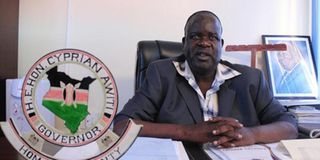Homa Bay County banks on factories to lift farmers’ fortunes

Homa Bay Governor Cyprian Awiti in his office. PHOTO | FILE
What you need to know:
- Homa Bay can be described as an agricultural hub because of the various crops grown in the county. They include maize, sugarcane, sweet potatoes, bananas, groundnuts, sunflower, cotton, pineapples and soya beans. Many households also keep animals. However, despite the diversity, farmers remain poor.
- We will adopt any technology as long as it betters production of fish. Currently, we have dug 21 fish breeding sites in Mfangano Island to ensure farmers get quality fingerlings. In addition, we have rolled out fish farming projects in all the 40 wards.
You recently launched the construction of Sh400 million animal feeds factory and Sh160 million maize milling plant. How are these projects going to benefit farmers?
We expect the factory to bring down the cost of animal feeds, a major input in livestock production. Once farmers get affordable quality feeds, they will be able to increase their production, thus, profits. The factory will produce seven tonnes or 100 70kg bags of animal feeds per hour. For the maize plant, farmers will no longer have to sell their produce cheaply to brokers.
Besides milling maize, the plant will also provide storage facilities to help minimise post-harvest losses.
The two factories will employ more than 1,000 people. Farmers will further gain by supplying the raw materials. These include omena, cassava, maize and rice brans and cotton and sunflower cakes. They will also own shares in the plants through cooperatives.
Cage fish farming is touted as the solution to dwindling fish production in Lake Victoria. Does your government have any plans of promoting the method of farming since the county borders the largest part of Lake Victoria?
We will adopt any technology as long as it betters production of fish. Currently, we have dug 21 fish breeding sites in Mfangano Island to ensure farmers get quality fingerlings. In addition, we have rolled out fish farming projects in all the 40 wards, where each has four model ponds. Fish farmers have also formed cooperative societies to help boost their earnings and productivity.
Homa Bay is one the largest producers of sweet potatoes in the country but farmers are not reaping from their efforts. What is your plan for farmers growing the crop?
The immediate thing to do is save them from middlemen. We have set up a satellite potato processing factory at Kabondo that will add value to the crop by processing it into fortified flour, crisps and other products.
My government has also laid down an elaborate marketing programme for the products, which involves selling to schools, colleges, hospitals and prisons. The future is bright for farmers.
You also intend to set up a pineapple processing factory in Rangwe sub-county but farmers are growing the crop on small-scale? How will you boost production of the crop to meet processing capacity?
There is a massive potential which has not been exploited. The county government is partnering with Industrial and Commercial Development Corporation (ICDC) to put up a pineapple processing plant at Kochia in Rangwe. With ready market and through groups, farmers will boost production.
Watermelon farming is also becoming attractive to farmers…
It is a crop we are keen on and we encourage farmers to grow it because its consumption is going up across the country. We will help them find better market for their produce.
Poor state of roads is hampering transportation of produce to the market. What is your government doing to alleviate the problem?
Most of our roads were in poor state in 2013 but we have since opened 480km in the 40 wards. Although most of the economic roads in Homa Bay belong to the national government, we are working with the Kenya National Highways Authority to better them. We recently rehabilitated the Sikri–Lida and Koguta-Sindo roads. We are now working on the Kadongo- Gendia Road.
Cooperatives are the best way to make farmers earn from their ventures but here in Homa Bay, farmers are not organised into groups.
As a government we know it’s only through the cooperative movement that our people will create wealth. We are running a campaign to have farmers join cooperatives. Ten cooperative societies have so far benefited from training. Eight new cooperative societies have been registered so far.





